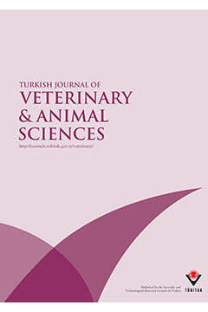Histomorphometric and fractal analysis of femoral, tibial, and metatarsal compact bone samples in sheep (Ovis aries), goat (Capra hircus), and roe deer (Capreolus capreolus)
Osteon, fractals, sheep, goat, roe deer, histomorphometry, archaeozoology, legal veterinary medicine
Histomorphometric and fractal analysis of femoral, tibial, and metatarsal compact bone samples in sheep (Ovis aries), goat (Capra hircus), and roe deer (Capreolus capreolus)
Osteon, fractals, sheep, goat, roe deer, histomorphometry, archaeozoology, legal veterinary medicine,
___
- Enlow DH, Brown SO. A comparative histological study of
- fossil and recent bone tissues. Part II. Tex I Sci 1957; 9: 186— 214.
- Enlow DH, Brown SO. A comparative histological study of
- fossil and recent bone tissues. Part III. Tex I Sci 1958; 10: 187— 230.
- In our study the utility of fractal analysis, as an analytical tool alongside the morphological assessment (both qualitative and quantitative), shows a promising potential for differentiating bone types between species and/or within a species. Further in-depth studies are needed to establish a clear pattern-map, with practical application in the speciŞc morphological identiŞcation of bone fragments.
- ISSN: 1300-0128
- Yayın Aralığı: 6
- Yayıncı: TÜBİTAK
Determination of serum cardiac biomarkers and plasma D-dimer levelsin anemic sheep with babesiosis
Özlem Orunç KILINÇ, Yaşar GÖZ, Nazmi YÜKSEK, Yildiray BAŞBUĞAN, Ali Bilgin YILMAZ, Ahmet Duran ATAŞ
Heparin-induced in vitro capacitation changes of swamp buffalo spermatozoa
Dibyajyoti TALUKDAR, Kutubuddin AHMED, Sourabh DEORI, Gopal Chandra DAS
Mohammed ABDELHAKIEM, Yuuhi ASAI, Hiroaki KAMISHINA, Masaaki KATAYAMA, Yuji UZUKA
The effects of dry-off therapy on milk somatic cell count in Saanen goats
AYHAN BAŞTAN, SEÇKİN SALAR, DUYGU BAKİ ACAR, MÜRŞİDE AYŞE DEMİREL, MEHMET CENGİZ, İSFENDİYAR DARBAZ, GAYE BULUT
ERVIN ZECEVIC, ADMIR DOKSO, AMRA KAZIC, MUHAMED BRKA
Evren ERDEM, Esin Ebru ONBAŞILAR, Özlem Gücüyener HACAN
Michal BEDNARSKI, Robert KUPCZYNSKI
Genetic relationships among four Turkish sheep breeds using microsatellites
Onur YILMAZ, Tamer SEZENLER, Semih SEVİM, İbrahim CEMAL, Orhan KARACA, Yalçin YAMAN, Orhan KARADAĞ
BETANIA MONTEIRO, LUKIYA FAVARATO, PABLO CARVALHO, BARBARA OKANO, MARIA ANTONIA MENEGATTI, ALVARO OLIVEIRA, BIANKA SANTOS, RICARDO DEL CARLO
Sung Woo KIM, Jin Seok CHOI, Neelesh SHARMA, Yeoung Gyu KO, Yoon Jung DO, Mijeong BYUN, Hwan Hoo SEONG, Soo Bong PARK, Dong Kee JEONG
